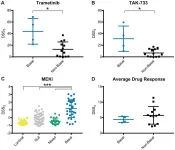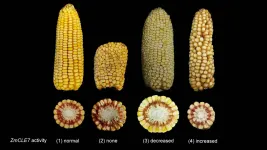(Press-News.org) Graphs -- data structures that show the relationship among objects -- are highly versatile. It's easy to imagine a graph depicting a social media network's web of connections. But graphs are also used in programs as diverse as content recommendation (what to watch next on Netflix?) and navigation (what's the quickest route to the beach?). As Ajay Brahmakshatriya summarizes: "graphs are basically everywhere."
Brahmakshatriya has developed software to more efficiently run graph applications on a wider range of computer hardware. The software extends GraphIt, a state-of-the-art graph programming language, to run on graphics processing units (GPUs), hardware that processes many data streams in parallel. The advance could accelerate graph analysis, especially for applications that benefit from a GPU's parallelism, such as recommendation algorithms.
Brahmakshatriya, a PhD student in MIT's Department of Electrical Engineering and Computer Science and the Computer Science and Artificial Intelligence Laboratory, will present the work at this month's International Symposium on Code Generation and Optimization. Co-authors include Brahmakshatriya's advisor, Professor Saman Amarasinghe, as well as Douglas T. Ross Career Development Assistant Professor of Software Technology Julian Shun, postdoc Changwan Hong, recent MIT PhD student Yunming Zhang PhD '20 (now with Google), and Adobe Research's Shoaib Kamil.
When programmers write code, they don't talk directly to the computer hardware. The hardware itself operates in binary -- 1s and 0s -- while the coder writes in a structured, "high-level" language made up of words and symbols. Translating that high-level language into hardware-readable binary requires programs called compilers. "A compiler converts the code to a format that can run on the hardware," says Brahmakshatriya. One such compiler, specially designed for graph analysis, is GraphIt.
The researchers developed GraphIt in 2018 to optimize the performance of graph-based algorithms regardless of the size and shape of the graph. GraphIt allows the user not only to input an algorithm, but also to schedule how that algorithm runs on the hardware. "The user can provide different options for the scheduling, until they figure out what works best for them," says Brahmakshatriya. "GraphIt generates very specialized code tailored for each application to run as efficiently as possible."
A number of startups and established tech firms alike have adopted GraphIt to aid their development of graph applications. But Brahmakshatriya says the first iteration of GraphIt had a shortcoming: It only runs on central processing units or CPUs, the type of processor in a typical laptop.
"Some algorithms are massively parallel," says Brahmakshatriya, "meaning they can better utilize hardware like a GPU that has 10,000 cores for execution." He notes that some types of graph analysis, including recommendation algorithms, require a high degree of parallelism. So Brahmakshatriya extended GraphIt to enable graph analysis to flourish on GPUs.
Brahmakshatriya's team preserved the way GraphIt users input algorithms, but adapted the scheduling component for a wider array of hardware. "Our main design decision in extending GraphIt to GPUs was to keep the algorithm representation exactly the same," says Brahmakshatriya. "Instead, we added a new scheduling language. So, the user can keep the same algorithms that they had before written before [for CPUs], and just change the scheduling input to get the GPU code."
This new, optimized scheduling for GPUs gives a boost to graph algorithms that require high parallelism -- including recommendation algorithms or internet search functions that sift through millions of websites simultaneously. To confirm the efficacy of GraphIt's new extension, the team ran 90 experiments pitting GraphIt's runtime against other state-of-the-art graph compilers on GPUs. The experiments included a range of algorithms and graph types, from road networks to social networks. GraphIt ran fastest in 65 of the 90 cases and was close behind the leading algorithm in the rest of the trials, demonstrating both its speed and versatility.
Brahmakshatriya says the new GraphIt extension provides a meaningful advance in graph analysis, enabling users to go between CPUs and GPUs with state-of-the-art performance with ease. "The field these days is tooth-and-nail competition. There are new frameworks coming out every day," He says. But he emphasizes that the payoff for even slight optimization is worth it. "Companies are spending millions of dollars each day to run graph algorithms. Even if you make it run just 5 percent faster, you're saving many thousands of dollars."
INFORMATION:
This research was funded, in part, by the National Science Foundation, U.S. Department of Energy, the Applications Driving Architectures Center, and the Defense Advanced Research Projects Agency.
Written by Daniel Ackerman, MIT News Office
Additional background
Paper: "Compiling Graph Applications for GPUs with GraphIt"
https://intimeand.space/docs/gpu-graphit.pdf
Understanding how the immune system responds to acute brain hemorrhage could open doors to identifying treatments for this devastating disease. However, up until now, there has been limited information on inflammation in the brain from human patients, especially during the first days after a hemorrhagic stroke.
This led a team of researchers to partner with a large clinical trial of minimally-invasive surgery to tackle defining the human neuroinflammatory response in living patients.
"Our goal was to find out, for the first time, how certain key cells of the immune system are activated when they enter the brain after a hemorrhage and how this may shift over the first week. This ...
For only the second time, astronomers have linked an elusive particle called a high-energy neutrino to an object outside our galaxy. Using ground- and space-based facilities, including NASA's Neil Gehrels Swift Observatory, they traced the neutrino to a black hole tearing apart a star, a rare cataclysmic occurrence called a tidal disruption event.
"Astrophysicists have long theorized that tidal disruptions could produce high-energy neutrinos, but this is the first time we've actually been able to connect them with observational evidence," said Robert Stein, a doctoral student at the German Electron-Synchrotron (DESY) research center in ...
In a time of extreme political polarization, hearing that a political candidate has taken a stance inconsistent with their party might raise some questions for their constituents.
Why don't they agree with the party's position? Do we know for sure this is where they stand?
New research led by University of Nebraska-Lincoln political psychologist Ingrid Haas has shown the human brain is processing politically incongruent statements differently -- attention is perking up -- and that the candidate's conviction toward the stated position is also playing a role.
In other words, there is a stronger neurological response happening when, for example, a Republican takes a position favorable to new taxes, ...
Abu Dhabi, UAE, February 22, 2021: Learning more about what motivates people to join violent ideological groups and engage in acts of cruelty against others is of great social and societal importance. New research from Assistant Professor of Psychology at NYUAD Jocelyn Bélanger explores the idea of ideological obsession as a form of addictive behavior that is central to understanding why people ultimately engage in ideological violence, and how best to help them break this addiction.
In the new study, END ...
Establishing a consistent sleep schedule for a toddler can be one of the most challenging aspects of child rearing, but it also may be one of the most important.
Research findings from a team including Lauren Covington, an assistant professor in the University of Delaware School of Nursing, suggest that children with inconsistent sleep schedules have higher body mass index (BMI) percentiles. Their findings, published in the Annals of Behavioral Medicine, suggest sleep could help explain the association between household poverty and BMI.
"We've known for a while that physical activity and diet quality are very strong predictors of weight and BMI," said Covington, the lead author of the article. "I think it's really highlighting that ...
February 22, 2021 - Widely used medications for benign prostatic hyperplasia (BPH) - also known as enlarged prostate - may be associated with a small, but significant increase in the probability of developing heart failure, suggests a study in The Journal of Urology®, Official Journal of the American Urological Association (AUA). The journal is pub lished in the Lippincott portfolio by Wolters Kluwer.
The risk is highest in men taking a type of BPH medication called alpha-blockers (ABs), rather than a different type called 5-alpha reductase inhibitors (5-ARIs), according to the new research by D. Robert Siemens, MD, and ...
Oncotarget recently published in "MEK is a promising target in the basal subtype of bladder cancer" by Merrill, et al. which reported that while many resources exist for the drug screening of bladder cancer cell lines in 2D culture, it is widely recognized that screening in 3D culture is more representative of in vivo response.
To address the need for 3D drug screening of bladder cancer cell lines, the authors screened 17 bladder cancer cell lines using a library of 652 investigational small-molecules and 3 clinically relevant drug combinations in 3D cell culture.
Their goal was to identify compounds and classes of compounds with efficacy in bladder cancer.
Utilizing ...
An international team of scientists, including two from Oregon State University, conducted a biological assessment of the world's rivers and the limited data they found presents a fairly bleak picture.
"For the places that we have data, the situations are not really that good. There are many species that are declining, threatened or endangered," said Bob Hughes, co-author of the paper and a courtesy associate professor in Oregon State's Department of Fisheries and Wildlife. "But for most of the globe, there just is little rigorous data."
The work by Hughes and the ...
By analyzing 50 years' worth of coral reef biodiversity studies, researchers reporting in the journal Current Biology on February 22 have quantified the practice of "parachute science," which happens when international scientists, typically from higher-income countries, conduct field studies in another, typically lower-income country, without engaging with local researchers. They found that institutions from several lower-middle- and upper-middle-income countries with abundant coral reefs produced less research than institutions based in high-income countries with fewer or in some cases no reefs. They also found that host-nation scientists (scientists from the nations where field research was conducted) were ...
Corn--or maize--has changed over thousands of years from weedy plants that make ears with less than a dozen kernels to the cobs packed with hundreds of juicy kernels that we see on farms today. Powerful DNA-editing techniques such as CRISPR can speed up that process. Cold Spring Harbor Laboratory (CSHL) Professor David Jackson and his postdoctoral fellow Lei Liu collaborated with University of Massachusetts Amherst Associate Professor Madelaine Bartlett to use this highly specific technique to tinker with corn kernel numbers. Jackson's lab is one of the first to apply CRISPR to corn's very complex ...





